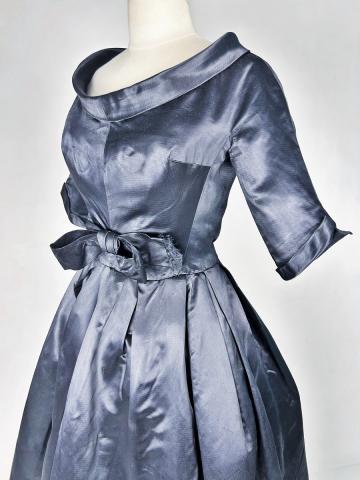Collection Automne Hiver 1957-1958
Paris
Rare robe de cocktail en satin cannelé noir de la dernière collection de Monsieur Christian Dior avant son décès le 23 octobre 1957. Ce modèle, numéroté 90999 est fidèle à la ligne Fuseau du maître qui nous précise que les jupes sont plus courtes et en fourreau, les bustes longs à décolletés plongeants en forme de cloche. Cette robe annonce le style d'Yves Mathieu Saint Laurent qui prendra la suite de Christian Dior. Ici le bustier intérieur est long en tulle rigide baleiné, agraffé dans le dos et comporte des jarretelles. La coupe est saillante, à manches trois-quarts, décolleté Claudine à revers, grand noeud assorti à la taille et montage de la jupe à larges plis creux. Le juponnage est impressionnant et correspond bien à la forme cloche avec quatre jupons dont trois de tulle noir bordés de crin et le dernier en fourreau de taffetas noir. Le satin cannelé est entièrement doublé d'organza noir pour une meilleure tenue. Fermeture éclair dans le dos. La griffe qui est cousue dans le corsage baleiné, indique Automne Hiver 1957 Christian Dior Paris, au numéro imprimé 90999. A signaler, une reprise mal faite sous le bras droit (sur 1 cm environ, voir dernière photo), facilement restaurable par un atelier professionnel, ainsi qu'une minucule décousure sous l'aisselle gauche, seuls défauts à signaler. Les textiles restent très résistants. Bel état général de couleur et de conservation.
Dimensions: Equivalent taille France 38. Taille 72 cm, poitrine 90 cm, hauteur 113 cm, épaules 40 cm, manches 28 cm, tour de jupe 360 cm environ.
Modèle approchant pour la coupe: modèle "Louvecienne", Christian Dior Heritage, Paris
Citation de Christian Dior: "Yves Saint Laurent est jeune, mais il a un immense talent. Dans ma dernière collection, j’estime que sur 180 modèles, il y en a 34 dont il est le père. Je pense que le moment est venu de le révéler à la presse. Mon prestige n’en souffrira pas."
Christian Dior à Jacques Rouet, en juillet 1957

